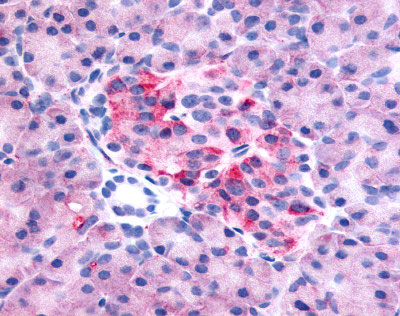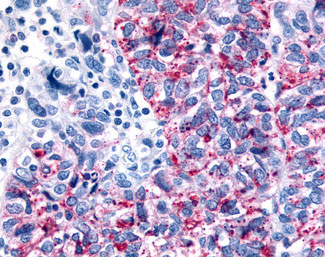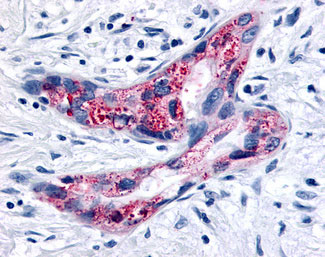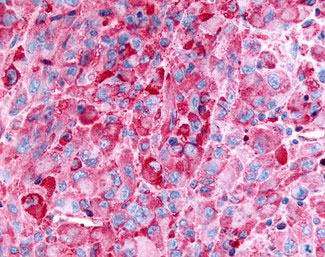GPR35 Antibody (C-Terminus)
Rabbit Polyclonal Antibody
- SPECIFICATION
- CITATIONS
- PROTOCOLS
- BACKGROUND

Application
| IHC-P, ICC |
|---|---|
| Primary Accession | Q9HC97 |
| Reactivity | Human |
| Host | Rabbit |
| Clonality | Polyclonal |
| Calculated MW | 34kDa |
| Dilution | IHC-P (12-23 µg/ml) |
| Gene ID | 2859 |
|---|---|
| Other Names | G-protein coupled receptor 35, Kynurenic acid receptor, KYNA receptor, GPR35 |
| Target/Specificity | Human GPR35. BLAST analysis of the peptide immunogen showed no homology with other human proteins. |
| Reconstitution & Storage | Long term: -70°C; Short term: +4°C |
| Precautions | GPR35 Antibody (C-Terminus) is for research use only and not for use in diagnostic or therapeutic procedures. |
| Name | GPR35 |
|---|---|
| Function | G-protein coupled receptor that binds to several ligands including the tryptophan metabolite kynurenic acid (KYNA), lysophosphatidic acid (LPA) or 5-hydroxyindoleacetic acid (5-HIAA) with high affinity, leading to rapid and transient activation of numerous intracellular signaling pathways (PubMed:16754668, PubMed:20361937, PubMed:35148838). Plays a role in neutrophil recruitment to sites of inflammation and bacterial clearance through the major serotonin metabolite 5-HIAA that acts as a physiological ligand (PubMed:35148838). Stimulates lipid metabolism, thermogenic, and anti- inflammatory gene expression in adipose tissue once activated by kynurenic acid (By similarity). In macrophages, activation by lysophosphatidic acid promotes GPR35-induced signaling with a distinct transcriptional profile characterized by TNF production associated with ERK and NF-kappa-B activation. In turn, induces chemotaxis of macrophages (By similarity). |
| Cellular Location | Cell membrane; Multi-pass membrane protein. Note=Internalized to the cytoplasm after exposure to kynurenic acid |
| Tissue Location | Predominantly expressed in immune and gastrointestinal tissues. |
| Volume | 50 µl |

Thousands of laboratories across the world have published research that depended on the performance of antibodies from Abcepta to advance their research. Check out links to articles that cite our products in major peer-reviewed journals, organized by research category.
info@abcepta.com, and receive a free "I Love Antibodies" mug.
Provided below are standard protocols that you may find useful for product applications.
Background
Acts as a receptor for kynurenic acid, an intermediate in the tryptophan metabolic pathway. The activity of this receptor is mediated by G-proteins that elicit calcium mobilization and inositol phosphate production through G(qi/o) proteins.
References
O'Dowd B.F.,et al.Genomics 47:310-313(1998).
Horikawa Y.,et al.Nat. Genet. 26:163-175(2000).
Warren C.N.,et al.Submitted (APR-2003) to the EMBL/GenBank/DDBJ databases.
Ota T.,et al.Nat. Genet. 36:40-45(2004).
Ebert L.,et al.Submitted (JUN-2004) to the EMBL/GenBank/DDBJ databases.
If you have used an Abcepta product and would like to share how it has performed, please click on the "Submit Review" button and provide the requested information. Our staff will examine and post your review and contact you if needed.
If you have any additional inquiries please email technical services at tech@abcepta.com.













 Foundational characteristics of cancer include proliferation, angiogenesis, migration, evasion of apoptosis, and cellular immortality. Find key markers for these cellular processes and antibodies to detect them.
Foundational characteristics of cancer include proliferation, angiogenesis, migration, evasion of apoptosis, and cellular immortality. Find key markers for these cellular processes and antibodies to detect them. The SUMOplot™ Analysis Program predicts and scores sumoylation sites in your protein. SUMOylation is a post-translational modification involved in various cellular processes, such as nuclear-cytosolic transport, transcriptional regulation, apoptosis, protein stability, response to stress, and progression through the cell cycle.
The SUMOplot™ Analysis Program predicts and scores sumoylation sites in your protein. SUMOylation is a post-translational modification involved in various cellular processes, such as nuclear-cytosolic transport, transcriptional regulation, apoptosis, protein stability, response to stress, and progression through the cell cycle. The Autophagy Receptor Motif Plotter predicts and scores autophagy receptor binding sites in your protein. Identifying proteins connected to this pathway is critical to understanding the role of autophagy in physiological as well as pathological processes such as development, differentiation, neurodegenerative diseases, stress, infection, and cancer.
The Autophagy Receptor Motif Plotter predicts and scores autophagy receptor binding sites in your protein. Identifying proteins connected to this pathway is critical to understanding the role of autophagy in physiological as well as pathological processes such as development, differentiation, neurodegenerative diseases, stress, infection, and cancer.





